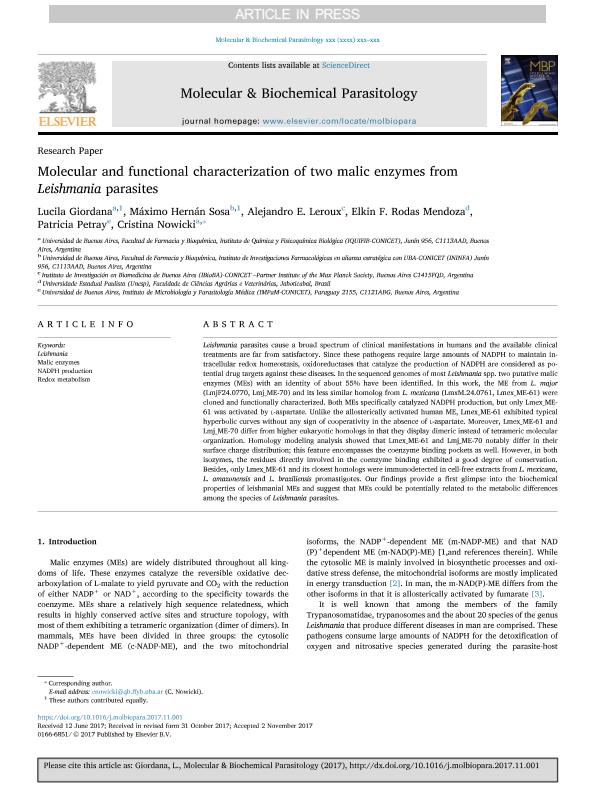Artículo
Molecular and functional characterization of two malic enzymes from Leishmania parasites
Giordana, Lucila ; Sosa, Máximo Hernán
; Sosa, Máximo Hernán ; Leroux, Alejandro Ezequiel
; Leroux, Alejandro Ezequiel ; Mendoza Rodas, Elkin F.; Petray, Patricia Beatriz
; Mendoza Rodas, Elkin F.; Petray, Patricia Beatriz ; Nowicki, Cristina
; Nowicki, Cristina
 ; Sosa, Máximo Hernán
; Sosa, Máximo Hernán ; Leroux, Alejandro Ezequiel
; Leroux, Alejandro Ezequiel ; Mendoza Rodas, Elkin F.; Petray, Patricia Beatriz
; Mendoza Rodas, Elkin F.; Petray, Patricia Beatriz ; Nowicki, Cristina
; Nowicki, Cristina
Fecha de publicación:
01/2018
Editorial:
Elsevier Science
Revista:
Molecular and Biochemical Parasitology
ISSN:
0166-6851
Idioma:
Inglés
Tipo de recurso:
Artículo publicado
Clasificación temática:
Resumen
Leishmania parasites cause a broad spectrum of clinical manifestations in humans and the available clinical treatments are far from satisfactory. Since these pathogens require large amounts of NADPH to maintain intracellular redox homeostasis, oxidoreductases that catalyze the production of NADPH are considered as potential drug targets against these diseases. In the sequenced genomes of most Leishmania spp. two putative malic enzymes (MEs) with an identity of about 55% have been identified. In this work, the ME from L. major (LmjF24.0770, Lmj_ME-70) and its less similar homolog from L. mexicana (LmxM.24.0761, Lmex_ME-61) were cloned and functionally characterized. Both MEs specifically catalyzed NADPH production, but only Lmex_ME-61 was activated by L-aspartate. Unlike the allosterically activated human ME, Lmex_ME-61 exhibited typical hyperbolic curves without any sign of cooperativity in the absence of L-aspartate. Moreover, Lmex_ME-61 and Lmj_ME-70 differ from higher eukaryotic homologs in that they display dimeric instead of tetrameric molecular organization. Homology modeling analysis showed that Lmex_ME-61 and Lmj_ME-70 notably differ in their surface charge distribution; this feature encompasses the coenzyme binding pockets as well. However, in both isozymes, the residues directly involved in the coenzyme binding exhibited a good degree of conservation. Besides, only Lmex_ME-61 and its closest homologs were immunodetected in cell-free extracts from L. mexicana, L. amazonensis and L. braziliensis promastigotes. Our findings provide a first glimpse into the biochemical properties of leishmanial MEs and suggest that MEs could be potentially related to the metabolic differences among the species of Leishmania parasites.
Palabras clave:
Leishmania
,
Malic Enzymes
,
Nadph Production
,
Redox Metabolism
Archivos asociados
Licencia
Identificadores
Colecciones
Articulos(IBIOBA - MPSP)
Articulos de INST. D/INV.EN BIOMED.DE BS AS-CONICET-INST. PARTNER SOCIEDAD MAX PLANCK
Articulos de INST. D/INV.EN BIOMED.DE BS AS-CONICET-INST. PARTNER SOCIEDAD MAX PLANCK
Articulos(IMPAM)
Articulos de INSTITUTO DE INVESTIGACIONES EN MICROBIOLOGIA Y PARASITOLOGIA MEDICA
Articulos de INSTITUTO DE INVESTIGACIONES EN MICROBIOLOGIA Y PARASITOLOGIA MEDICA
Articulos(ININFA)
Articulos de INST.DE INVEST.FARMACOLOGICAS (I)
Articulos de INST.DE INVEST.FARMACOLOGICAS (I)
Articulos(IQUIFIB)
Articulos de INST.DE QUIMICA Y FISICO-QUIMICA BIOLOGICAS "PROF. ALEJANDRO C. PALADINI"
Articulos de INST.DE QUIMICA Y FISICO-QUIMICA BIOLOGICAS "PROF. ALEJANDRO C. PALADINI"
Citación
Giordana, Lucila; Sosa, Máximo Hernán; Leroux, Alejandro Ezequiel; Mendoza Rodas, Elkin F.; Petray, Patricia Beatriz; et al.; Molecular and functional characterization of two malic enzymes from Leishmania parasites; Elsevier Science; Molecular and Biochemical Parasitology; 219; 1-2018; 67-76
Compartir
Altmétricas



